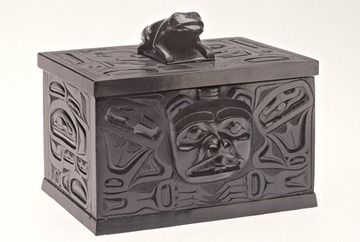The remarkable sophistication and complexity of the vibrant Haida culture is explored in a special exhibition presented through January 23, 2011 at the Canadian Museum of Civilization. Haida: Life. Spirit. Art features more than 80 masterpieces from the outstanding Haida collection of the McCord Museum in Montréal.
 Most of the objects date from the 18th and 19th centuries and reflect the great skill of Haida artists and the richness of their ancient culture. The artifacts range from intricate bentwood boxes to a beautifully painted woven hat; from carved fish-hooks to model totem poles. They provide fascinating insights into a culture that took root thousands of years ago in Haida Gwaii (formerly the Queen Charlotte Islands) and remains vibrant today along Canada’s Northwest Coast.
Most of the objects date from the 18th and 19th centuries and reflect the great skill of Haida artists and the richness of their ancient culture. The artifacts range from intricate bentwood boxes to a beautifully painted woven hat; from carved fish-hooks to model totem poles. They provide fascinating insights into a culture that took root thousands of years ago in Haida Gwaii (formerly the Queen Charlotte Islands) and remains vibrant today along Canada’s Northwest Coast.
“This exhibition is a wonderful complement to our own permanent exhibits devoted to the Haida’s captivating and enduring culture,” says Dr. Victor Rabinovitch, President and CEO of the Canadian Museum of Civilization Corporation. “We are grateful to the McCord Museum for organizing this exhibition and allowing us to share it with our visitors.”
The exhibition, which debuted at the McCord Museum, was developed with the guidance of renowned Haida artist Robert Davidson, and also features his art and insight. Davidson has described art as the Haida’s only written language, preserving ancient customs and beliefs and keeping the Haida spirit alive.
Most of the artworks were collected in 1878 during a visit to Haida Gwaii by George Mercer Dawson, then chief geologist of the Geological Survey of Canada.
Haida: Life. Spirit. Art
Life and Art on Haida Gwaii provides an introduction to the Haida’s homeland on the Northwest Coast and the remarkable visual arts tradition that has flourished there since ancient times. Here we learn about the vital role of artists as communicators in this oral society—how they preserved and passed along ideas through complex shapes and images expertly rendered in wood, stone and other materials. We are also introduced to George Mercer Dawson of the Geological Survey of Canada, who collected most of the objects in the exhibition during a visit to Haida Gwaii in 1878. Artifacts in this section include wooden seal clubs and fish hooks, beautifully engraved with animal images. This section also notes the establishment and the devastating consequences of European contact.
Ceremonial Art explores the complex and intriguing structure of traditional Haida society, and the intangible riches that have been passed on through generations. The intangible wealth includes the rights to songs, dances and designs. Here we learn about the Haida’s two social groups or moieties—Raven and Eagle—and we discover how to unlock some of the secrets embedded in Haida symbols and crests. Among the many notable artworks are a superbly carved bowl featuring a raven’s head clasping a human in its beak; dramatic masks and rattles used by chiefs during potlatch ceremonies; and a pair of bowls of exceptional age and elegance.
A third section, Art for Export, examines the impact of trade on Haida art. Here we discover how bartering with neighbouring Aboriginal peoples and Europeans gave the Haida access to new materials and spurred the creation of objects tailored for these trading partners. Artifacts in this section include miniature totem poles—masterpieces carved from a black stone called argillite—and a spectacular oval platter that portrays a mythical sea creature and is adorned with iridescent abalone shell.
Source: Art Daily [January 03, 2011]